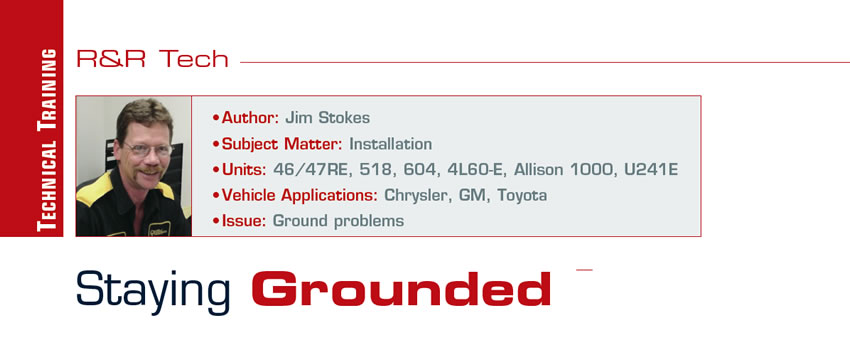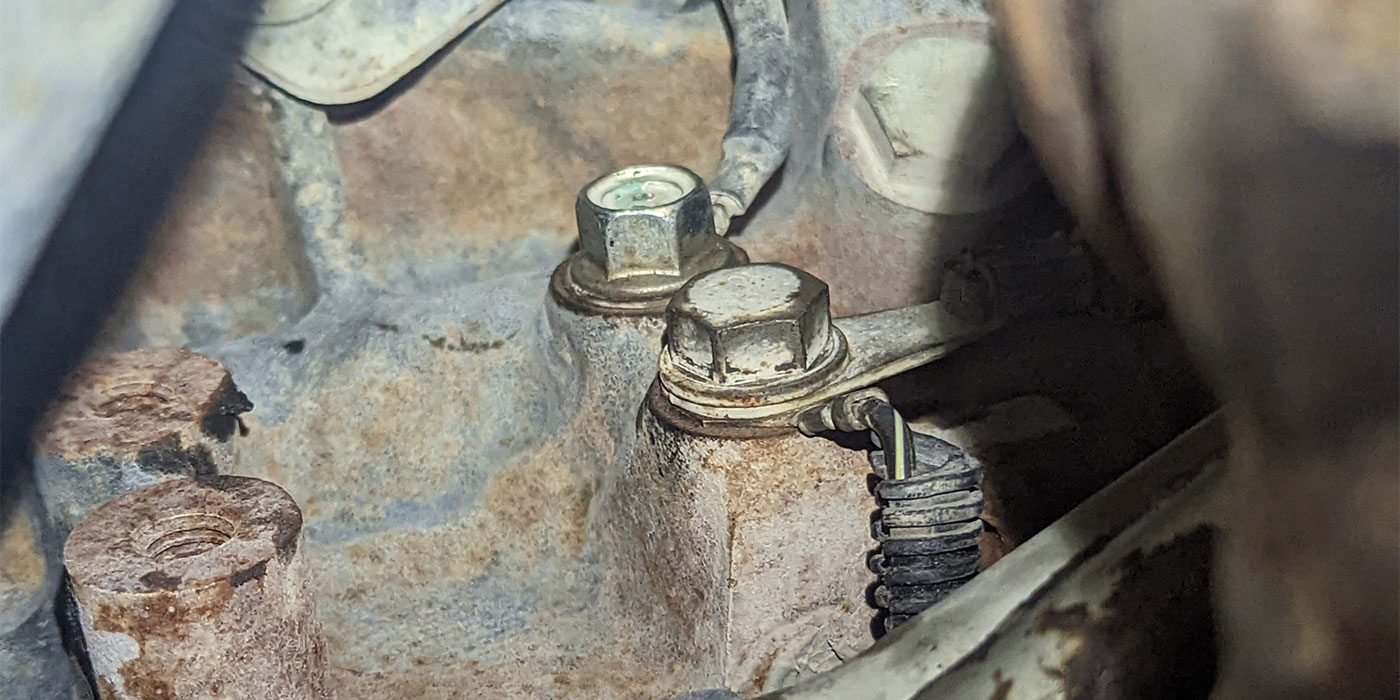
R&R Tech
- Author: Jim Stokes
- Subject Matter: Installation
- Units: 46/47RE, 518, 604, 4L60-E, Allison 1000, U241E
- Vehicle Applications: Chrysler, GM, Toyota
- Issue: Ground problems
As a member of our team of technical advisers, I have come across many different scenarios that have been traced to the improper grounding of a component, or case. There are many different symptoms, but all have a common cause and repair: They are all elated to a grounding problem in an electrical circuit of the vehicle. We always think about the importance of source voltage, but the ground side of the circuit is equally important. As automotive design has evolved over time, the electrical integrity of all control circuits is critical for proper function.
The following cases are some real-world examples of customer complaints, symptoms and repairs that were traced to faulty ground circuits.

- Unit: Chrysler 46/47RE
- Vehicle: 1999 Dodge R2500 4WD 5.9 diesel 47RE
- Complaint: Bucks while being driven
One of the most-common complaints on the 46/47RE units is the torque-converter clutch (TCC) being commanded on and off when the vehicle is being driven at moderate speeds. In this case, we could see the solenoid being commanded on and off, causing the vehicle to buck and the tachometer to fluctuate. In most instances, the most-common repair is to direct the accelerator-pedal-position (APP) sensor signal from pin 3 directly to the powertrain control module (PCM) at pin 23, to bypass the circuit through the engine control module (ECM). In this instance, however, this method of repair was not successful. To complete the repair, the installer had to add another ground from pin 4 of the APP sensor directly to one of the battery negative terminals. This circuit normally goes from pin 4 of the APP sensor to ECM pin 32. That ground had been compromised, so the overlay cured the issue.

- Unit: Chrysler 518
- Vehicle: 1999 Dodge R2500 4WD 5.9 gas
- Complaint: Third-gear starts, no shifts
We don’t see this complaint nearly as often as we did five (or so) years ago, but it still shows up in our shops on occasion. The transmission can have third-gear starts with no upshifts or downshifts, or erratic shifting and no TCC engagement, TCC cycling, and various codes for the O2 sensors and/or governor sensor codes, or sometimes no codes. In the subject vehicle, only two codes were present: P0133 (1/1 O2 sensor slow to respond) and P0152 (2/1 O2 sensor shorted to voltage).
The O2-sensor diagnostics revealed that the sensors were good, but the ground circuit for them (through splice S122) was found to have a lot of green corrosion in it, causing all the related circuits to work erratically. All the circuits in the splice were cleaned up and resealed, and ground 125 at the front of the engine was also cleaned for better contact. After these repairs, both the O2 sensors and the governor solenoid functioned correctly.

- Unit: Chrysler 604
- Vehicle: 2004 Chrysler Town and Country FWD 3.8L
- Complaint: Harsh, bumpy coast downshifts
This vehicle had a remanufactured transmission installed in it. As per normal procedure, the pinion factor was reset, and the quick-learn procedure was performed prior to the post-installation road test. Everything performed normally, with no warning lights or codes, so the vehicle was delivered to the customer.
Eight days after delivery, the customer brought the vehicle back with a complaint of harsh, bumpy downshifts when coasting to a stop. The diagnostician confirmed the condition, performed the quick learn again and found that the downshifts were acceptable. This cycle repeated itself four to five times over the course of a month, so the installing shop filed a warranty claim to get assistance with diagnosing the problem.
Starting with the basics, we had the alternator output checked and the three-month-old battery tested. Both were functioning within specs. Next, we had the battery output circuits tested with a voltage-drop test, and the results showed just over 2 volts being lost in the circuit. The cable to the starter had only a 0.10-volt drop, so the loss was apparently on the return side of the circuit.
Simply replacing the negative battery cable restored the circuit and eliminated the excessive voltage drop. The vehicle was again delivered to the customer but had no other issues afterward.

- Unit: GM 4L60-E
- Vehicle: 1993 K1500 pickup, 5.7L
- Complaint: Harsh 1-2 shift, firm 2-3 shift
After installation of a remanufactured unit, the installer called us with a complaint of a harsh 1-2 shift and a firm 2-3 shift. The previous unit was having the same problem before it was finally replaced for a no-reverse condition. Scan-tool data showed an actual reading of 1.10 amps for the pressure-control-solenoid command in drive at idle.
A pressure gauge was installed, and in drive at 650 rpm the pressure reading was 130 psi. The installer didn’t have an amp probe available, so he placed the DVOM in amp mode and hard-wired in series to the return circuit of the PC solenoid at pin D, near the transmission-harness connector. While the scan tool showed 1.1 amps in the parameter identification data, the ammmeter wired into the return circuit had an actual reading of 0.09A. They did not match.
This indicated that the ECM was not able to properly ground the circuit to control the line pressure. A replacement ECM was readily available, but an updated EPROM was not. After replacement of the ECM, the unit had 72 psi in drive at idle, the shifts were smooth, and the vehicle was delivered. Since this case, I have assisted in this diagnosis 20 times or more all across the country.

- Unit: Allison 1000
- Vehicle: 2002 K2500 pickup, 6.6L Duramax
- Complaint: Code P0741 (TCC stuck off)
After installation of a remanufactured transmission, code P0741 (TCC system stuck off) was set during a road test. This code was also present prior to installation of the replacement transmission. The previous unit failed primarily from the loud grinding and crunching noises in the gear train but also had this code stored in memory.
The TCM data showed that the TCC circuit was being commanded on at a 100% duty cycle and had a slip reading of 160 rpm on a level road at moderate throttle. A continuity test of the voltage supply and return circuit was performed, and both circuits had little to no resistance. When the solenoid was bi-directionally controlled with the transmission in gear at idle and applied at 100%, there was an obvious load on the engine. The idle speed dipped by 150 rpm but the engine did not stall as expected.
We had the installer trace the transmission harness from the TCM to the transmission, and a small black box was found wired into the harness at the firewall. Wires were found coming out from and also back into the harness. When he removed the box from the firewall, it was noted that it was labeled as an “Engine Brake Controller.” The technician removed the wiring from the box and repaired the circuits that were cut in the harness. He then performed the fast-learn procedure again and completed the relearn drive procedure. The TCC operation then returned to normal and on the same level road as tested previously had a 45% apply cycle and zero slip reading. Though this was not a true ground repair, the return ground was altered to the TCM, and that is what caused the circuit to fail.

- Unit: Toyota U241E
- Vehicle: 2001 RAV4 2.0L
- Complaint: No engine cranking; dash lights stay on and heater fan runs with ignition switch off
This case also starts with a fresh installation of a remanufactured transmission. After the installation, the engine wouldn’t turn over, the dash lights stayed on with the ignition switch turned off, and the heater blower fan ran with the switch in the off position. The battery checked good with 13.5 volts.
As the technician was preparing to perform a voltage-drop test on the starter circuit, the technician working on the vehicle said his test light glowed when grounded at the negative battery terminal and with the positive probe connected to the transmission case. A DVOM reading showed 9.3V. He then removed all the ground connections to the transmission case, cleaned the terminals and the contact locations on the case and also cleaned the frame-contact location for the cables on the other end.
After these corrections, the voltage reading at the case dropped to 0.3V, and the starter functioned correctly. After addition of an auxiliary ground cable from the case to the negative battery terminal, the case voltage reading dropped to 0.05V. The vehicle was then delivered to the customer.
As with any diagnostic process, it all comes down to the basics. Modern vehicle electronic controls and sensors rely on tiny levels of voltage to use computer logic that controls engine, transmission and other vehicle systems. In turn, if circuits or components interfere with those tiny voltages, subsystems will become erratic and can cause some puzzling vehicle behaviors. Grounds are often overlooked, yet so simple to test and correct.

Jim Stokes is a warranty technical consultant for Certified Transmission. He holds a current ASE Master Technician + L1 certification and has been with the company more than 14 years.













